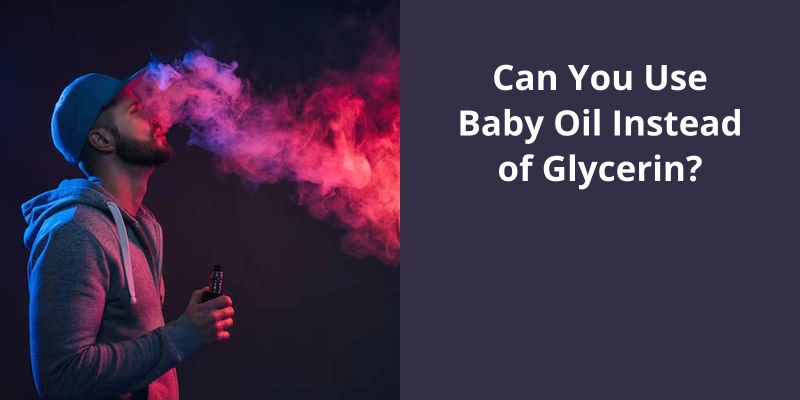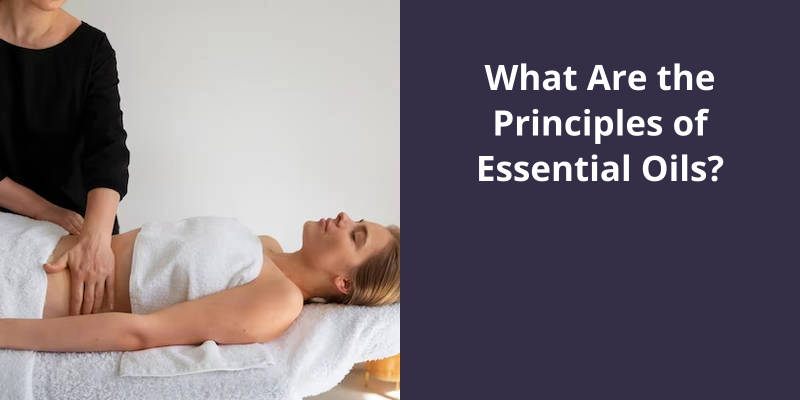Yes, you can use baby oil as an alternative to glycerin but it won’t have the exact same properties. Though they are both moisturizing agents, they have key differences. Glycerin is a humectant, pulling moisture into the skin, while baby oil, derived mostly from mineral oil, works by forming a barrier on the skin’s surface to lock in moisture. The result might be slightly different as glycerin can hydrate the skin more deeply. Baby oil is also more likely to clog pores, which may cause breakouts if used on the face. Therefore, while it’s possible to use baby oil instead of glycerin, it’s important to take these factors into consideration depending on the intended use.

Is Baby Oil and Glycerin the Same?
In terms of their chemical structure, baby oil and glycerin arent even remotely similar. Baby oil is typically composed of mineral oil, which is a highly refined form of petroleum. This gives it a consistency thats thicker and more viscous than that of glycerin, which is a clear and slightly sticky substance. While both substances are often used for cosmetic purposes, they serve very different functions.
One common use for baby oil is as a skin moisturizer. It’s consistency allows it to form a protective layer over the skin, helping to lock in moisture and prevent dehydration. Glycerin, on the other hand, is more commonly used as a humectant. This means that it’s the ability to attract water molecules and help trap them close to the skins surface, which can be beneficial for people with dry skin.
Whether youre using them to moisturize dry skin, hydrate your hair, or add some shine to your makeup routine, they can be valuable assets in your personal care arsenal. Just be sure to choose the right product for your needs – while they may look similar, not all oils are created equal.
When it comes to skincare, glycerin is a commonly used ingredient known for it’s hydrating properties. However, for those who prefer to avoid this ingredient for various reasons such as allergies or ethical concerns, there are several alternatives available. In this article, we will explore some of the top substitutes for glycerin in skincare, including options such as cocoa and shea butter, as well as avocado oil and jojoba oil.
What Is a Good Substitute for Glycerin in Skincare?
Cocoa and shea butter are both natural ingredients that have become increasingly popular in the skincare industry due to their moisturizing and healing properties. These butters work wonders on dry and damaged skin, leaving it soft, smooth, and radiantly healthy. Shea butter is particularly effective at improving skin elasticity, reducing wrinkles, and fighting against premature aging.
Avocado oil and jojoba oil are two other natural ingredients that are often used in skincare as substitutes for glycerin. Avocado oil is rich in vitamins A, D, and E and is known for it’s ability to deeply penetrate the skin, leaving it soft and smooth. Jojoba oil, which is actually a liquid wax, is perfect for those with oily and acne-prone skin as it mimics the skins natural sebum, allowing it to regulate oil production and prevent clogged pores.
There are many benefits to using natural substitutes like these in skincare products. Not only are they gentle on the skin, but they’re also free from harsh chemicals and synthetic ingredients that can irritate or damage the skin. They’re also more sustainable and eco-friendly than many traditional skincare ingredients, making them a great choice for those who’re looking to reduce their environmental impact.
It’s always best to do a patch test on a small area of skin before using any new skincare product to avoid any adverse reactions or allergies. It’s also important to speak to a dermatologist or other skincare professional if you’ve any concerns or questions about which skincare ingredients are best for your individual needs and skin type.
So if you’re looking to avoid glycerin in your baking, using vegetable oil can be a viable option. Not only does it provide the same binding properties, it also offers a neutral taste that won’t affect the overall flavor of your baked goods.
Can You Use Oil Instead of Glycerin?
Glycerin is a common ingredient in many commercially-produced food products, as well as in some homemade recipes. However, some people may choose to avoid glycerin for various reasons – such as allergies, dietary restrictions, or simply personal preferences. In these cases, substitutes for glycerin may be needed. One option is to use vegetable oil in place of glycerin.
When substituting vegetable oil for glycerin in a recipe, it’s important to pay attention to the quantities. The ratios may vary depending on the specific recipe and ingredients being used. Some recipes may require more oil to achieve a similar effect as glycerin. It’s also worth noting that using oil may result in a slightly different texture or taste in the finished product – so some experimentation may be required to get the desired results.
While glycerin is non-toxic and safe for consumption in small amounts, it’s often derived from animal fats or petroleum sources. Vegetable oil, on the other hand, is made from plant-based sources such as soybeans, canola, or sunflowers. This makes it a more sustainable and environmentally-friendly choice as well.
That being said, it’s important to keep in mind that vegetable oil is still high in fat and calories. So while it may be a good alternative to glycerin in some cases, it should still be used in moderation as part of a balanced diet. It’s also important to choose a high-quality, minimally processed vegetable oil for maximum health benefits.
Other Alternatives to Glycerin in Recipes
There are several alternatives available to glycerin in recipes, such as honey, vegetable glycerin, coconut oil, xylitol, and corn syrup. These can provide similar properties to glycerin, such as moisture retention and sweetness. It’s best to experiment with different substitutes to find the right one for your particular recipe.
Source: What liquid product can I substitute for vegetable glycerin?..
Now that we know that glycerin is naturally present in various sources, including coconut oil, let’s dive deeper into the question of whether or not coconut oil can be classified as glycerin.
Is Coconut Oil a Glycerin?
Coconut oil has risen to popularity in recent years due to it’s perceived health benefits. Many people use it as a cooking oil, moisturizer, hair conditioner, and even as a natural sunscreen. However, there’s a common misconception that coconut oil is a glycerin.
Glycerin is a colorless, odorless, sweet-tasting liquid that’s used in a wide range of products, such as soaps, cosmetics, and medicines. It’s a type of sugar alcohol that’s naturally present in all animal fat and vegetable oils, including coconut oil. Coconut oil is made up of a complex mixture of fatty acids, including lauric acid, caprylic acid, and capric acid.
Coconut oil is often touted for it’s moisturizing properties. When applied topically, it can help to hydrate the skin and improve it’s overall texture. This is because coconut oil has a high concentration of medium-chain fatty acids, which are easily absorbed by the skin and help to lock in moisture.
It’s important to note that not all coconut oils are created equal. Some coconut oils may have higher or lower glycerin content depending on how they were produced. For example, some coconut oils are refined using harsh chemicals, which can strip the oil of it’s natural glycerin content.
The Differences Between Refined and Unrefined Coconut Oil: As Mentioned in the Article, the Refining Process Can Impact the Glycerin Content of Coconut Oil. Additional Information on Differences in Nutrients and Potential Health Benefits Between Refined and Unrefined Coconut Oil Could Be Included.
One of the key differences between refined and unrefined coconut oil is the refinement process that can affect the glycerin content in the oil. In addition, there can be variations in the nutrients and potential health benefits between the two types of coconut oil.
Making your own homemade glycerin is a popular way to save money and benefit from a natural product that you make yourself. In this article, we will explore the step-by-step process of making homemade glycerin from leftover animal fats using simple ingredients that are readily available.
How Do You Make Homemade Glycerin?
The first step in making homemade glycerin is to gather the necessary materials and tools. This includes animal fat, lye, salt, a large pot or kettle, a wooden spoon, a thermometer, and a strainer. It’s important to note that the animal fat should come from a reputable source and be free of any additives or preservatives.
Once you’ve your materials, the next step is to render the animal fat. This process involves slowly heating the fat in a pot or kettle until it melts down into a liquid. This liquid fat is then strained to remove any impurities or solid bits. It’s important to be careful during this step as the liquid fat can get very hot and can cause serious burns if spilled.
Once the fat has been rendered, the next step is to add lye to the mixture. This is done slowly and carefully while stirring constantly with a wooden spoon. The lye will cause the fat to turn into soap and release glycerin as a byproduct. It’s important to wear gloves and protective eyewear during this step as lye is a highly corrosive substance.
After the lye has been added, the mixture is left to cook for several hours. During this time, it will transform into a thick, gel-like consistency. The temperature of the mixture should be monitored using a thermometer and kept at a steady temperature to ensure proper chemical reactions occur.
Finally, the mixture is broken using salt. This causes the glycerin to separate from the soap and rise to the surface. The mixture is then strained once again to remove any remaining impurities. The glycerin can be stored in a clean, airtight container for future use.
When it comes to baking and creating delicious treats, sometimes ingredients can be hard to come by. One common question that pops up is whether coconut oil can be used as a replacement for glycerin in royal icing. The good news is that since coconut oil is an ingredient in vegetable-based glycerin, it can be a great replacement option when glycerin isn’t available. Let’s explore the details of this substitution and how it can affect the outcome of your baking endeavors.
Can I Use Coconut Oil Instead of Glycerin in Royal Icing?
Royal icing is a popular decorative frosting often used in cake decorating and traditional cookie making. It’s typically made with powdered sugar, egg whites, and glycerin to give it the smooth, shiny finish decorators strive for. However, one may ask if coconut oil could be a substitute for glycerin in royal icing.
Coconut oil has a sweet, nutty flavor and is frequently utilized in cooking and baking dishes. It functions as a perfect replacement ingredient to various food products and even finds applications across various industries. Coconut oil is also an active ingredient in vegetable-based glycerin, which is a popular derivate of fats and oils.
The choice of whether to use coconut oil instead of glycerin comes down to individual preferences. Some people may prefer the unique taste that coconut oil brings to the table, while others may not be a fan.
While it’s important to note that some recipes may require glycerin only and lack substitution options, certain cookie recipes may vary. It’s best to experiment with the recipe and craft the ideal results for individual preferences. For example, coconut oil may be a solid at room temperature, so it may not mix as effectively into the powdered sugar-egg white combination.
Still, it may take some experimentation to achieve the desired consistency and flavor.
What Are the Benefits of Using Coconut Oil in Baking and Cooking?
Coconut oil has several benefits when used in baking and cooking, including adding moisture to baked goods and providing a healthier alternative to other oils. It can also enhance the flavor of certain dishes and has been shown to have antibacterial and antifungal properties.
Conclusion
In conclusion, while glycerin may be the preferred option for creating a fun and sparkly sensory experience, there are viable alternatives such as olive oil, vegetable oil, and even baby oil. This allows for flexibility in creating a unique and personalized sensory jar or calming bottle that suits individual preferences and needs. It’s important to keep in mind the proper ratio of liquid to glycerin or oil to ensure optimal results.





